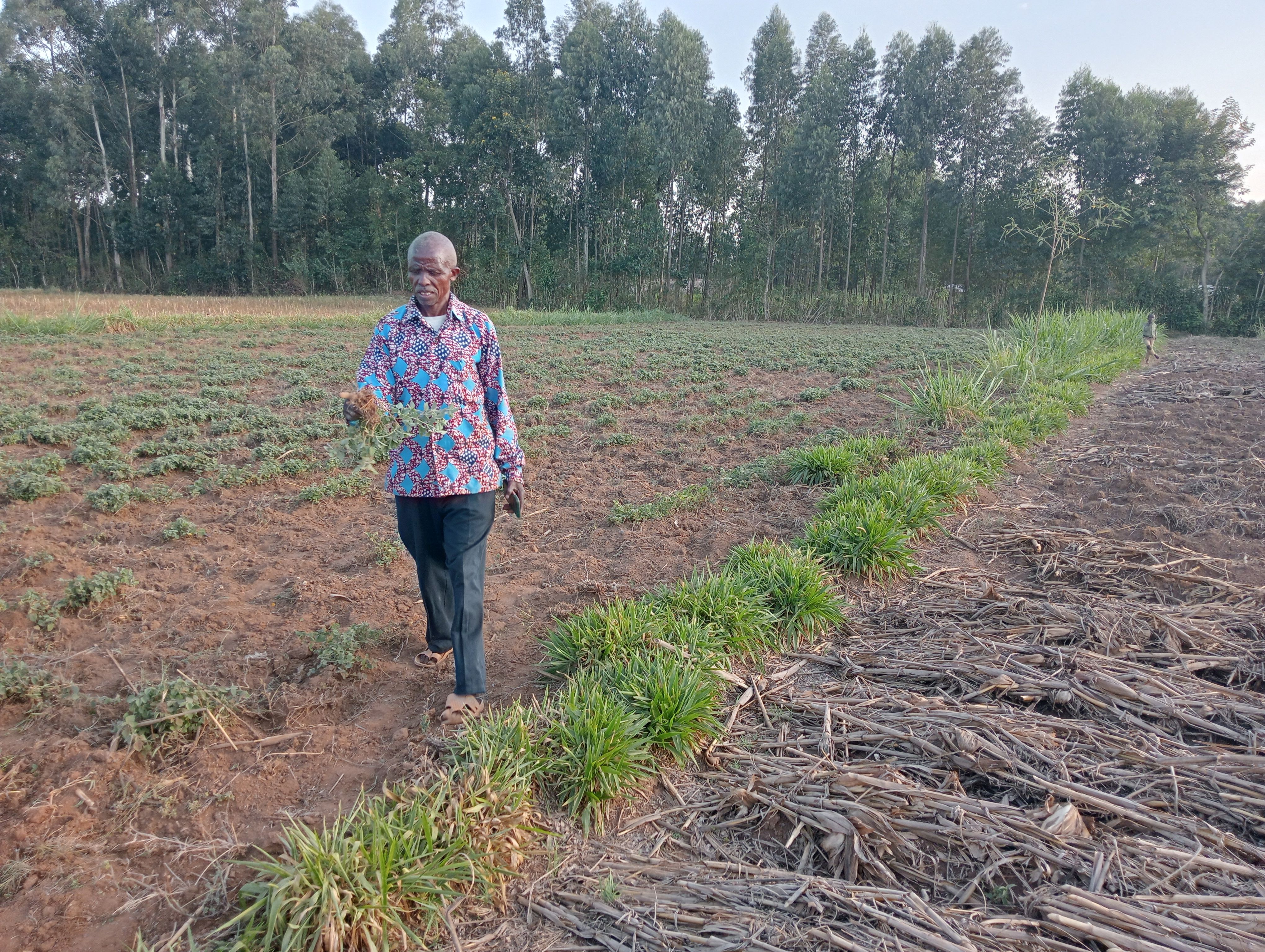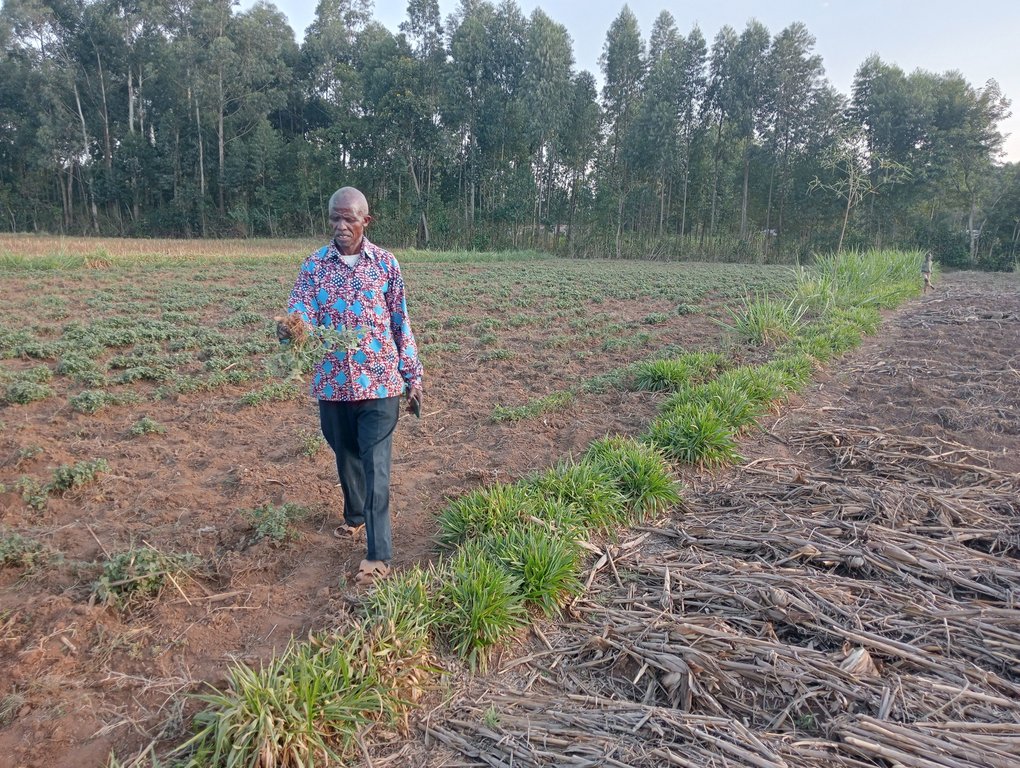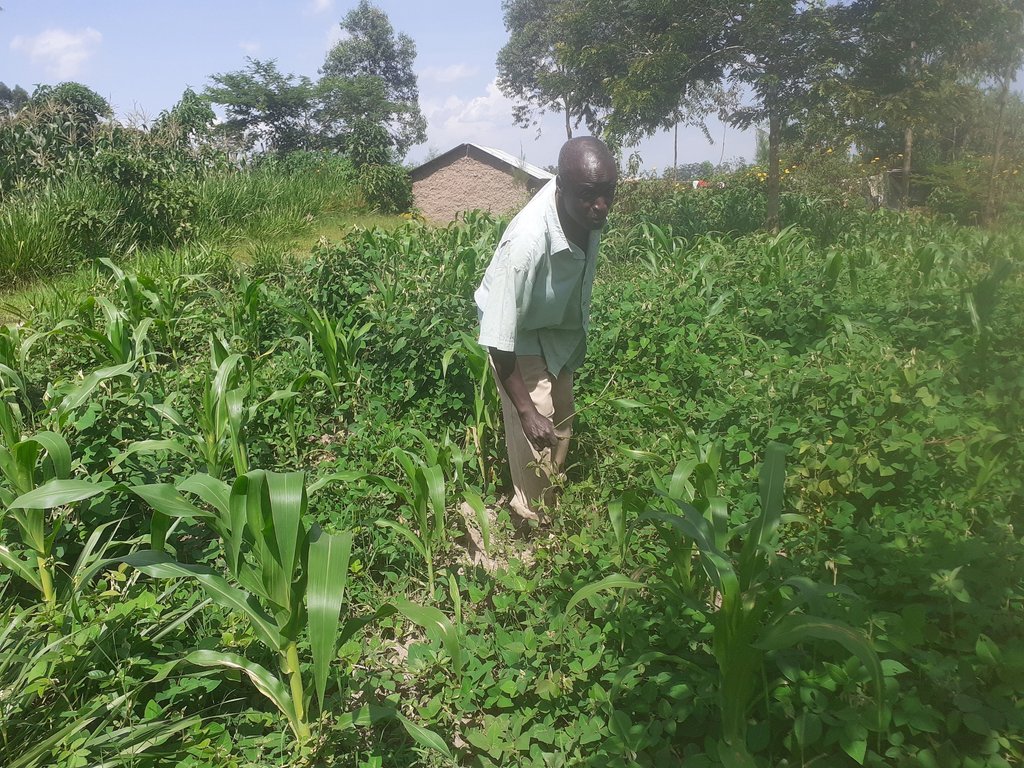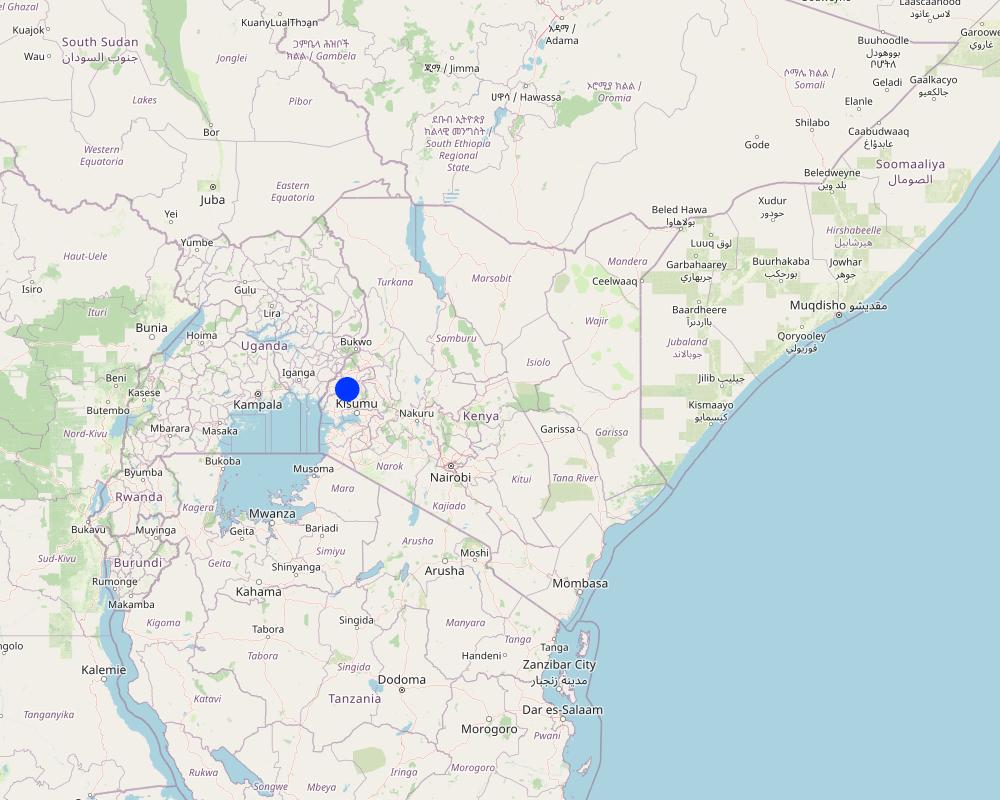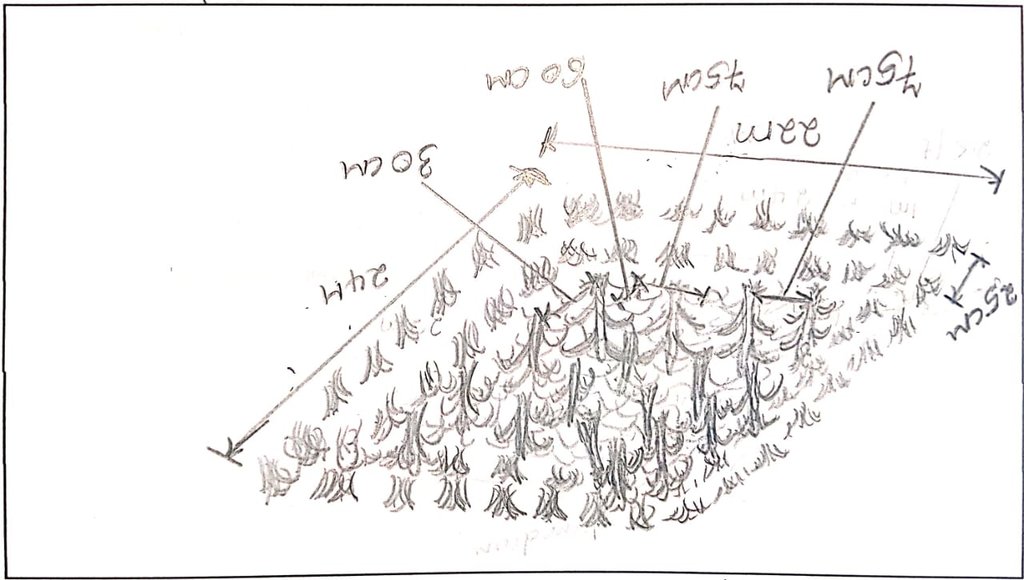Push-pull crop pest control [เคนยา]
- ผู้สร้างสรรค์:
- การอัพเดท:
- ผู้รวบรวม: William Akwanyi
- ผู้เรียบเรียง: George Onyango, Innocent Faith, Noel Templer, JUSTINE OTSYULA, Tabitha Nekesa, Ahmadou Gaye, Siagbé Golli
- ผู้ตรวจสอบ: William Critchley, Rima Mekdaschi Studer, Sally Bunning
technologies_6701 - เคนยา
ดูส่วนย่อย
ขยายทั้งหมด ย่อทั้งหมด1. ข้อมูลทั่วไป
1.2 รายละเอียดที่ติดต่อได้ของผู้รวบรวมและองค์กรที่เกี่ยวข้องในการประเมินและการจัดเตรียมทำเอกสารของเทคโนโลยี
วิทยากรหลัก
ผู้ใช้ที่ดิน:
Keya Andrew Mulaa
Welthungerhilfe farmer
เคนยา
ผู้เชี่ยวชาญ SLM:
ผู้เชี่ยวชาญ SLM:
ชื่อของโครงการซึ่งอำนวยความสะดวกในการทำเอกสารหรือการประเมินเทคโนโลยี (ถ้าเกี่ยวข้อง)
Soil protection and rehabilitation for food security (ProSo(i)l)ชื่อขององค์กรซึ่งอำนวยความสะดวกในการทำเอกสารหรือการประเมินเทคโนโลยี (ถ้าเกี่ยวข้อง)
Deutsche Gesellschaft für Internationale Zusammenarbeit (GIZ)ชื่อขององค์กรซึ่งอำนวยความสะดวกในการทำเอกสารหรือการประเมินเทคโนโลยี (ถ้าเกี่ยวข้อง)
Alliance Bioversity and International Center for Tropical Agriculture (Alliance Bioversity-CIAT) - เคนยา1.3 เงื่อนไขการใช้ข้อมูลที่ได้บันทึกผ่านทาง WOCAT
ผู้รวบรวมและวิทยากรหลักยอมรับเงื่อนไขเกี่ยวกับการใช้ข้อมูลที่ถูกบันทึกผ่านทาง WOCAT:
ใช่
1.4 การเปิดเผยเรื่องความยั่งยืนของเทคโนโลยีที่ได้อธิบายไว้
เทคโนโลยีที่ได้อธิบายไว้นี้เป็นปัญหาของความเสื่อมโทรมโทรมของที่ดินหรือไม่ จึงไม่ได้รับการยอมรับว่าเป็นเทคโนโลยีเพื่อการจัดการที่ดินอย่างยั่งยืน:
ไม่ใช่
แสดงความคิดเห็น:
The technology has not adversely affected the farms of farmers who have implemented the technology.
2. การอธิบายลักษณะของเทคโนโลยี SLM
2.1 การอธิบายแบบสั้น ๆ ของเทคโนโลยี
คำจำกัดความของเทคโนโลยี:
Push-pull technology is a strategy that controls pests, improves the productivity of cereal crops and fodder, and controls soil erosion.
2.2 การอธิบายแบบละเอียดของเทคโนโลยี
คำอธิบาย:
Push–pull technology was developed by the International Centre of Insect Physiology and Ecology (ICIPE) in collaboration with Rothamsted Research, (UK) in Kenya in the 1990s for the control of stemborer and striga weed in resource-poor maize farming systems. It is a strategy for controlling pests by using plants that repel them i.e., “push” crops and plants that trap pests i.e., “pull” crops. In Kakamega, Siaya, and Bungoma counties of western Kenya (i.e., the ProSoil project areas), the production of maize, millet, and sorghum has greatly been affected by poor soil fertility; insect pests, especially stemborer; and a parasitic weed called striga. Under the ProSoil project, Desmodium intortum is the main repellent “push” crop while napier grass (Pennisetum purpureum), brachiaria (Brachiaria decumbens), and mulatto (Brachiaria ruziziensis) are the main “pull” or trap plants.
In a typical push-pull system, the attractant “pull” plant is planted as a border around the field where the main crop e.g., maize, millet, or sorghum has been intercropped with the “push” crop. Desmodium produces repellent volatile chemicals that push away stemborer moths from the main field towards the edge where there is the “pull” or trap crop. The attractant trap plant emits volatile compounds which serve as a haven for the stemborers. As the stemborer moths lay eggs on the pull/ trap plant (in this case bracharia) and the eggs hatch and develop into larvae or caterpillar stage, a sticky substance like glue secreted by the bracharia physically traps the larvae; hence, inhibiting further development. In addition, desmodium stimulates the germination of striga and then effectively inhibits its growth through its roots' exudates.
“Push-pull” technology improves the productivity of cereal crops, controls soil erosion, and contributes to conservation agriculture (minimum tillage). Desmodium and bracharia are both high-quality animal fodder plants and because of their perennial nature, they maintain ground cover. Bracharia is rich in crude protein. Desmodium is a leguminous green manure cover crop and, therefore, it fixes nitrogen in the soil and improves soil organic matter. Desmodium does not suppress the main crop since it is not a climber.
One acre (0.4 ha) of land (in a push-pull system) requires about 0.75 kg of desmodium seeds and about 0.5 kg of brachiaria seeds. Desmodium is planted at a spacing of 75 cm between rows and 60 cm between plants in the same row. The cereal crop is established in rows parallel to the desmodium crop rows (e.g., 75 cm from row to row and 30 cm from plant to plant in the same row for maize). Brachiaria is planted in two shallow trenches (50 cm apart) and because the seeds are very tiny, they are sown on the surface of the trenches and covered with a very thin layer of soil to keep them in place, in darkness, until they sprout. They are later thinned to give a spacing of 25 cm between plants.
2.3 รูปภาพของเทคโนโลยี
2.4 วีดีโอของเทคโนโลยี
ความคิดเห็น/อธิบายสั้นๆ:
https://www.youtube.com/watch?v=QbX1RWBGZI4&ab_channel=WilliamOnura
A farmer demonstrating how to prune desmodium roots using an African sword and how to break the ground/ soil using a chaka hoe.
วันที่:
11/02/2023
สถานที่:
Andrew Mulla's farm in Lunyu Village, Khalaba Ward, Matungu Sub-county, in Kakamega County
ชื่อผู้ถ่ายวีดีโอ:
William Akwanyi
2.5 ประเทศภูมิภาค หรือสถานที่ตั้งที่เทคโนโลยีได้นำไปใช้และได้รับการครอบคลุมโดยการประเมินนี้
ประเทศ:
เคนยา
ภูมิภาค/รัฐ/จังหวัด:
Kakamega County in western Kenya
ข้อมูลจำเพาะเพิ่มเติมของสถานที่ตั้ง :
Khalaba Ward, Matungu Sub-county, in Kakamega County
ระบุการกระจายตัวของเทคโนโลยี:
- กระจายไปอย่างสม่ำเสมอในพื้นที่
If precise area is not known, indicate approximate area covered:
- < 0.1 ตร.กม.(10 เฮกตาร์)
Is/are the technology site(s) located in a permanently protected area?
ไม่ใช่
แสดงความคิดเห็น:
There are no protected areas in the areas covered by this assessment. The stated area is the total area of the two fields where the information that was used in this documentation was collected from. Only one field (Andrew's) was used for most of the documentation e.g., field measurements and costs estimation. Nice photos of the technology were taken in the other field (Patrick's).
Map
×2.6 วันที่การดำเนินการ
ระบุปีที่ใช้:
2019
2.7 คำแนะนำของเทคโนโลยี
ให้ระบุว่าเทคโนโลยีถูกแนะนำเข้ามาอย่างไร:
- ทางโครงการหรือจากภายนอก
ความคิดเห็น (ประเภทของโครงการ เป็นต้น) :
Technology introduced by the ProSoil project.
3. การจัดประเภทของเทคโนโลยี SLM
3.1 วัตถุประสงค์หลักของเทคโนโลยี
- ปรับปรุงการผลิตให้ดีขึ้น
- รักษาสภาพหรือปรับปรุงความหลากหลายทางชีวภาพ
- ปรับตัวเข้ากับการเปลี่ยนแปลงภูมิอากาศของโลก สภาพภูมิอากาศที่รุนแรงและผลกระทบ
- ชะลอการเปลี่ยนแปลงภูมิอากาศของโลกและผลกระทบ
- สร้างผลกระทบทางด้านเศรษฐกิจที่เป็นประโยชน์
3.2 ประเภทของการใช้ที่ดินในปัจจุบันที่ได้นำเทคโนโลยีไปใช้
Land use mixed within the same land unit:
ใช่
Specify mixed land use (crops/ grazing/ trees):
- การปลูกพืชร่วมกับปศุสัตว์และการทำป่าไม้ (Agro-silvopastoralism)

พื้นที่ปลูกพืช
- การปลูกพืชล้มลุกอายุปีเดียว
- การปลูกพืชยืนต้นที่ไม่มีเนื้อไม้
- การปลูกไม้ยืนต้น ไม้พุ่ม
Annual cropping - Specify crops:
- fodder crops - grasses
- fodder crops - clover
- cereals - maize
- cereals - sorghum
- vegetables - other
- legumes and pulses - beans
Annual cropping system:
Maize/sorghum/millet intercropped with legume
Perennial (non-woody) cropping - Specify crops:
- banana/plantain/abaca
- sugar cane
- fodder crops - grasses
- fodder crops - legumes, clover
Tree and shrub cropping - Specify crops:
- fodder trees (Calliandra, Leucaena leucocephala, Prosopis, etc.)
- avocado
- fruits, other
- mango, mangosteen, guava
- papaya
จำนวนของฤดูเพาะปลูกต่อปี:
- 2
ระบุ:
Crops are grown during the long and short rain seasons.
Is intercropping practiced?
ใช่
If yes, specify which crops are intercropped:
Cereal and legumes.
Is crop rotation practiced?
ใช่
ถ้าใช่ ระบุ:
The push-pull plot is left fallow with only the repellant and attractant crops.

ทุ่งหญ้าเลี้ยงสัตว์
ทุ่งหญ้าเลี้ยงสัตว์ที่มีการจัดการแบบเข้มข้นหรือการผลิตอาหารสัตว์:
- ตัดแล้วขนไป / ไม่มีการปล่อยแทะเล็มเอง (Cut-and-carry / zero grazing)
- ทุ่งหญ้าเลี้ยงสัตว์ที่ได้มีการปรับปรุง (Improved pastures)
Animal type:
- cattle - dairy
- goats
- poultry
Is integrated crop-livestock management practiced?
ใช่
ถ้าใช่ ระบุ:
Desmodium and napier grass are fodder crops - fed to livestock. Manure from the animals is applied on the cereal crops.
ผลิตภัณฑ์และบริการ:
- economic security, investment prestige
- milk
- manure as fertilizer/ energy production
- eggs
- meat
Species:
cattle - dairy
Count:
3
Species:
poultry
Count:
55
Species:
goats
Count:
4
3.3 Has land use changed due to the implementation of the Technology?
Has land use changed due to the implementation of the Technology?
- No (Continue with question 3.4)
3.4 การใช้น้ำ
การใช้น้ำของที่ดินที่มีการใช้เทคโนโลยีอยู่:
- จากน้ำฝน
แสดงความคิดเห็น:
Crop establishment is dependent on availability of rainfall.
3.5 กลุ่ม SLM ที่ตรงกับเทคโนโลยีนี้
- ระบบหมุนเวียน (การปลูกพืชหมุนเวียน การพักดิน การเกษตรแบบไร่เลื่อนลอย)
- การจัดการปลูกพืชร่วมกับปศุสัตว์
- การจัดการศัตรูพืชและโรคพืชแบบผสมผสาน (รวมถึงเกษตรอินทรีย์ด้วย)
3.6 มาตรการ SLM ที่ประกอบกันเป็นเทคโนโลยี

มาตรการจัดการพืช
- A1: พืช/สิ่งปกคลุมดิน
- A2: อินทรียวัตถุในดิน/ความอุดมสมบูรณ์ในดิน
- A3: การรักษาหน้าดิน

มาตรการอนุรักษ์ด้วยวิธีพืช
- V2: หญ้าและไม้ยืนต้น
3.7 รูปแบบหลักของการเสื่อมโทรมของที่ดินที่ได้รับการแก้ไขโดยเทคโนโลยี

การกัดกร่อนของดินโดยน้ำ
- Wt (Loss of topsoil): การสูญเสียดินชั้นบนหรือการกัดกร่อนที่ผิวดิน

การกัดกร่อนของดินโดยลม
- Et (Loss of topsoil): การสูญเสียดินชั้นบน
3.8 การป้องกัน การลดลง หรือการฟื้นฟูความเสื่อมโทรมของที่ดิน
ระบุเป้าหมายของเทคโนโลยีกับความเสื่อมโทรมของที่ดิน:
- ป้องกันความเสื่อมโทรมของที่ดิน
4. ข้อมูลจำเพาะด้านเทคนิค กิจกรรมการนำไปปฏิบัติใช้ ปัจจัยนำเข้า และค่าใช้จ่าย
4.1 แบบแปลนทางเทคนิคของเทคโนโลยี
ข้อมูลจำเพาะด้านเทคนิค (แบบแปลนทางเทคนิคของเทคโนโลยี):
Trap crop at the edge (brachiaria): 50 cm x 25 cm
Repellant crop (desmodium): 75 cm x 60 cm
Cereal crop (maize intercropped with desmodium): 75 cm x 30 cm
ผู้เขียน:
William Akwanyi
วันที่:
11/02/2023
4.2 ข้อมูลทั่วไปเกี่ยวกับการคำนวณปัจจัยนำเข้าและค่าใช้จ่าย
ให้ระบุว่าค่าใช้จ่ายและปัจจัยนำเข้าได้รับการคำนวณอย่างไร:
- ต่อพื้นที่ที่ใช้เทคโนโลยี
ระบุขนาดและหน่วยพื้นที่:
0.0528 ha
อื่นๆ หรือสกุลเงินประจำชาติ (ระบุ):
KES
If relevant, indicate exchange rate from USD to local currency (e.g. 1 USD = 79.9 Brazilian Real): 1 USD =:
124.21
ระบุค่าเฉลี่ยของค่าจ้างในการจ้างแรงงานต่อวัน:
KES 250.00
4.3 กิจกรรมเพื่อการจัดตั้ง
| กิจกรรม | Timing (season) | |
|---|---|---|
| 1. | Land preparation | Before rains |
| 2. | Seed sourcing | Before rains |
| 3. | Planting | After rains |
แสดงความคิดเห็น:
Land should be ploughed only when there are stubborn weeds.
4.4 ค่าใช้จ่ายของปัจจัยนำเข้าที่จำเป็นสำหรับการจัดตั้ง
| ปัจจัยนำเข้า | หน่วย | ปริมาณ | ค่าใช้จ่ายต่อหน่วย | ค่าใช้จ่ายทั้งหมดต่อปัจจัยนำเข้า | %ของค่าใช้จ่ายที่ก่อให้เกิดขึ้นโดยผู้ใช้ที่ดิน | |
|---|---|---|---|---|---|---|
| แรงงาน | Land preparation | Man-days | 4.0 | 250.0 | 1000.0 | 100.0 |
| อุปกรณ์ | Slasher | No. | 1.0 | 70.0 | 70.0 | |
| อุปกรณ์ | African machete (panga) | No. | 1.0 | 80.0 | 80.0 | |
| อุปกรณ์ | Jab planter | No. | 1.0 | 1000.0 | 1000.0 | |
| วัสดุด้านพืช | Bracharia seeds | Kgs | 0.1 | 420.0 | 42.0 | |
| วัสดุด้านพืช | Desmodium seeds | Kgs | 0.26 | 420.0 | 109.2 | |
| วัสดุด้านพืช | Maize seeds | Kgs | 1.0 | 180.0 | 180.0 | 100.0 |
| ปุ๋ยและสารฆ่า/ยับยั้งการเจริญเติบโตของสิ่งมีชีวิต (ไบโอไซด์) | Manure | Wheelbarrows | 30.0 | 70.0 | 2100.0 | |
| ค่าใช้จ่ายทั้งหมดของการจัดตั้งเทคโนโลยี | 4581.2 | |||||
| Total costs for establishment of the Technology in USD | 36.88 | |||||
ถ้าผู้ใช้ที่ดินรับภาระน้อยกว่า 100% ของค่าใช้จ่าย ให้ระบุว่าใครเป็นผู้รับผิดชอบส่วนที่เหลือ:
ProSoil project through Welthungerhilfe.
แสดงความคิดเห็น:
The ProSoil project through Welthungerhilfe provided slashers, African swords, and jab planters to the farmers through their groups. The costs of these implements are KES 350/- for a slasher, KES 400/- for a panga (machete), and KES 5,000/- for a jab planter. It is assumed that the farmer will be able to use these implements over a period of 5 years before these implements will have depreciated to a point where they will not be useable. The cost is thus spread over the years when the farmer will be able to use the implement.
4.5 การบำรุงรักษาสภาพหรือกิจกรรมที่เกิดขึ้นเป็นประจำ
| กิจกรรม | ช่วงระยะเวลา/ความถี่ | |
|---|---|---|
| 1. | Shallow weeding | Twice during maize crop growing period |
| 2. | Ripping | Before maize re-establishement |
| 3. | Root management | Before maize re-establishement |
4.6 ค่าใช้จ่ายของปัจจัยนำเข้าและกิจกรรมที่เกิดขึ้นเป็นประจำที่ต้องการการบำรุงรักษา (ต่อปี)
| ปัจจัยนำเข้า | หน่วย | ปริมาณ | ค่าใช้จ่ายต่อหน่วย | ค่าใช้จ่ายทั้งหมดต่อปัจจัยนำเข้า | %ของค่าใช้จ่ายที่ก่อให้เกิดขึ้นโดยผู้ใช้ที่ดิน | |
|---|---|---|---|---|---|---|
| แรงงาน | Shallow weeding | Man-days | 2.0 | 250.0 | 500.0 | |
| แรงงาน | Root management | Man-days | 2.0 | 250.0 | 500.0 | |
| แรงงาน | Ripping | Man-days | 4.0 | 250.0 | 1000.0 | |
| อุปกรณ์ | Shallow weeder | No. | 1.0 | 80.0 | 80.0 | |
| อุปกรณ์ | Chaka hoe | No. | 1.0 | 130.0 | 130.0 | |
| อุปกรณ์ | African machete (panga) | No. | 1.0 | 80.0 | 80.0 | |
| ค่าใช้จ่ายทั้งหมดของการบำรุงรักษาสภาพเทคโนโลยี | 2290.0 | |||||
| Total costs for maintenance of the Technology in USD | 18.44 | |||||
ถ้าผู้ใช้ที่ดินรับภาระน้อยกว่า 100% ของค่าใช้จ่าย ให้ระบุว่าใครเป็นผู้รับผิดชอบส่วนที่เหลือ:
ProSoil project through Welthungerhilfe.
แสดงความคิดเห็น:
The ProSoil project through Welthungerhilfe provided Shallow weeders, pangas (machete), and chaka hoes to the farmers through their groups. The costs of these implements are KES 400/- for a slasher, KES 400/- for an African sword, and KES 650/- for a jab planter. It is assumed that the farmer will be able to use these implements over a period of 5 years before these implements will have depreciated to a point where they will not be useable. The cost is thus spread over the years when the farmer will be able to use the implement.
4.7 ปัจจัยสำคัญที่สุดที่มีผลกระทบต่อค่าใช้จ่าย
ปัจจัยสำคัญที่สุดที่มีผลกระทบต่อค่าใช้จ่ายต่างๆ:
Rate of man-days vary from one place to another, farmer to farmer, and with type of work.
Exchange rate for February 2023, source: European Commission/ InfoEuro online at https://commission.europa.eu/funding-tenders/procedures-guidelines-tenders/information-contractors-and-beneficiaries/exchange-rate-inforeuro_en
5. สิ่งแวดล้อมทางธรรมชาติและของมนุษย์
5.1 ภูมิอากาศ
ฝนประจำปี
- < 250 ม.ม.
- 251-500 ม.ม.
- 501-750 ม.ม.
- 751-1,000 ม.ม.
- 1,001-1,500 ม.ม.
- 1,501-2,000 ม.ม.
- 2,001-3,000 ม.ม.
- 3,001-4,000 ม.ม.
- > 4,000 ม.ม.
ระบุปริมาณน้ำฝนเฉลี่ยรายปี (ถ้ารู้) :หน่วย ม.ม.
1300.00
ข้อมูลจำเพาะ/ความคิดเห็นเรื่องปริมาณน้ำฝน:
Monthly rainfall variability is high with some months such as January recording less than 5 mm of total rainfall.
ระบุชื่อของสถานีตรวดวัดอากาศที่ใช้อ้างอิงคือ:
Kakamega Meteorological Station
เขตภูมิอากาศเกษตร
- ชื้น
The climate in the area favours most agricultural activities.
5.2 สภาพภูมิประเทศ
ค่าเฉลี่ยความลาดชัน:
- ราบเรียบ (0-2%)
- ลาดที่ไม่ชัน (3-5%)
- ปานกลาง (6-10%)
- เป็นลูกคลื่น (11-15%)
- เป็นเนิน (16-30%)
- ชัน (31-60%)
- ชันมาก (>60%)
ธรณีสัณฐาน:
- ที่ราบสูง/ที่ราบ
- สันเขา
- ไหล่เขา
- ไหล่เนินเขา
- ตีนเนิน
- หุบเขา
ระดับความสูง:
- 0-100 เมตร
- 101-500 เมตร
- 501-1,000 เมตร
- 1,001-1,500 เมตร
- 1,501-2,000 เมตร
- 2,001-2,500 เมตร
- 2,501-3,000 เมตร
- 3,001-4,000 เมตร
- > 4,000 เมตร
ให้ระบุถ้าเทคโนโลยีได้ถูกนำไปใช้:
- ไม่เกี่ยวข้อง
5.3 ดิน
ค่าเฉลี่ยความลึกของดิน:
- ตื้นมาก (0-20 ซ.ม.)
- ตื้น (21-50 ซ.ม.)
- ลึกปานกลาง (51-80 ซ.ม.)
- ลึก (81-120 ซ.ม.)
- ลึกมาก (>120 ซ.ม.)
เนื้อดิน (ดินชั้นบน):
- ปานกลาง (ดินร่วน ทรายแป้ง)
เนื้อดินล่าง (> 20 ซ.ม.ต่ำจากผิวดิน):
- ปานกลาง (ดินร่วน ทรายแป้ง)
อินทรียวัตถุในดิน:
- ปานกลาง (1-3%)
(ถ้ามี) ให้แนบคำอธิบายเรื่องดินแบบเต็มหรือระบุข้อมูลที่มีอยู่ เช่น ชนิดของดิน ค่า pH ของดินหรือความเป็นกรดของดิน ความสามารถในการแลกเปลี่ยนประจุบวก ไนโตรเจน ความเค็ม เป็นต้น:
Soil pH was 4.8 before push-pull was implented.
5.4 ความเป็นประโยชน์และคุณภาพของน้ำ
ระดับน้ำใต้ดิน:
5-50 เมตร
น้ำไหลบ่าที่ผิวดิน:
ปานกลาง
คุณภาพน้ำ (ที่ยังไม่ได้บำบัด):
เป็นน้ำเพื่อการดื่มที่ดี
Water quality refers to:
ground water
ความเค็มของน้ำเป็นปัญหาหรือไม่:
ไม่ใช่
กำลังเกิดน้ำท่วมในพื้นที่หรือไม่:
ไม่ใช่
ความคิดเห็นและข้อมูลจำเพาะเพิ่มเติมเรื่องคุณภาพและปริมาณน้ำ:
There are several boreholes in the area and according to interviews with some borehole owners, the depths are not more than 50 metres.
5.5 ความหลากหลายทางชีวภาพ
ความหลากหลายทางชนิดพันธุ์:
- สูง
ความหลากหลายของแหล่งที่อยู่:
- สูง
ความคิดเห็นและข้อมูลจำเพาะเพิ่มเติมของความหลากหลายทางชีวภาพ:
Most farms are under crops and trees therefore the agrobiodiversity is high.
5.6 ลักษณะของผู้ใช้ที่ดินที่นำเทคโนโลยีไปปฏิบัติใช้
อยู่กับที่หรือเร่ร่อน:
- อยู่กับที่
แนวทางการตลาดของระบบการผลิต:
- mixed (subsistence/ commercial)
รายได้ที่มาจากนอกฟาร์ม:
- > 50% ของรายได้ทั้งหมด
ระดับของความมั่งคั่งโดยเปรียบเทียบ:
- พอมีพอกิน
เป็นรายบุคคล/ครัวเรือน:
- เป็นรายบุคคล/ครัวเรือน
ระดับของการใช้เครื่องจักรกล:
- งานที่ใช้แรงกาย
เพศ:
- หญิง
- ชาย
อายุของผู้ใช้ที่ดิน:
- ผู้เยาว์
- วัยกลางคน
- ผู้สูงอายุ
5.7 Average area of land used by land users applying the Technology
- < 0.5 เฮกตาร์
- 0.5-1 เฮกตาร์
- 1-2 เฮกตาร์
- 2-5 เฮกตาร์
- 5-15 เฮกตาร์
- 15-50 เฮกตาร์
- 50-100 เฮกตาร์
- 100-500 เฮกตาร์
- 500-1,000 เฮกตาร์
- 1,000-10,000 เฮกตาร์
- >10,000 เฮกตาร์
พิจารณาว่าเป็นขนาดเล็ก กลาง หรือขนาดใหญ่ (ซึ่งอ้างอิงถึงบริบทระดับท้องถิ่น):
- ขนาดกลาง
5.8 กรรมสิทธิ์ในที่ดิน สิทธิในการใช้ที่ดินและสิทธิในการใช้น้ำ
กรรมสิทธิ์ในที่ดิน:
- รายบุคคล ไม่ได้รับสิทธิครอบครอง
- รายบุคคล ได้รับสิทธิครอบครอง
สิทธิในการใช้ที่ดิน:
- เช่า
- รายบุคคล
สิทธิในการใช้น้ำ:
- เกี่ยวกับชุมชน (ถูกจัดระเบียบ)
Are land use rights based on a traditional legal system?
ไม่ใช่
แสดงความคิดเห็น:
The farmer has a title for his piece of land. He also leases other people's pieces of land for farming. Water in the streams and springs is freely accessed with restrictions.
5.9 การเข้าถึงบริการและโครงสร้างพื้นฐาน
สุขภาพ:
- จน
- ปานกลาง
- ดี
การศึกษา:
- จน
- ปานกลาง
- ดี
ความช่วยเหลือทางด้านเทคนิค:
- จน
- ปานกลาง
- ดี
การจ้างงาน (เช่น ภายนอกฟาร์ม):
- จน
- ปานกลาง
- ดี
ตลาด:
- จน
- ปานกลาง
- ดี
พลังงาน:
- จน
- ปานกลาง
- ดี
ถนนและการขนส่ง:
- จน
- ปานกลาง
- ดี
น้ำดื่มและการสุขาภิบาล:
- จน
- ปานกลาง
- ดี
บริการด้านการเงิน:
- จน
- ปานกลาง
- ดี
แสดงความคิดเห็น:
The above rating varies from one village to the other.
6. ผลกระทบและสรุปคำบอกกล่าว
6.1 ผลกระทบในพื้นที่ดำเนินการ (On-site) จากการใช้เทคโนโลยี
ผลกระทบทางด้านเศรษฐกิจและสังคม
การผลิต
การผลิตพืชผล
จำนวนก่อน SLM:
2
หลังจาก SLM:
5
แสดงความคิดเห็น/ระบุ:
Quantity refers to the number of 90 Kg bags of maize produced per acre. Based on the farmer's experience.
คุณภาพพืชผล
แสดงความคิดเห็น/ระบุ:
Not easy to quantify. The crops do better compared to the past. Based on the farmer's estimate.
การผลิตพืชที่ใช้เลี้ยงปศุสัตว์
จำนวนก่อน SLM:
0
หลังจาก SLM:
10
แสดงความคิดเห็น/ระบุ:
Quantity refers to amount of bracharia and desmodium in tonnes per year. Based on the farmer's estimate.
คุณภาพพืชที่ใช้เลี้ยงปศุสัตว์
แสดงความคิดเห็น/ระบุ:
Not easy to quantify. Fodder does better compared to how it was before the technology. Based on the farmer's estimate.
การผลิตสัตว์
จำนวนก่อน SLM:
2
หลังจาก SLM:
8
แสดงความคิดเห็น/ระบุ:
Quantity refers to the amount of milk in litres from one cow. Based on the farmer's estimate.
การเสี่ยงต่อความล้มเหลวในการผลิต
จำนวนก่อน SLM:
70
หลังจาก SLM:
30
แสดงความคิดเห็น/ระบุ:
Quantity refers to the percentage probability of the crop failing to do well. Based on the farmer's estimate.
การจัดการที่ดิน
แสดงความคิดเห็น/ระบุ:
Not easy to quantify but it is easier to prepare land through no tillage than to plough. Based on the farmer's estimate.
รายได้และค่าใช้จ่าย
ค่าใช่จ่ายของปัจจัยการผลิตทางการเกษตร
จำนวนก่อน SLM:
7,000
หลังจาก SLM:
0
แสดงความคิดเห็น/ระบุ:
Quantity refers to the amount of money in Kenya shillings spend on inorganic fertilizers in a season. The farmer no longer buys money inorganic fertilizers.
รายได้จากฟาร์ม
จำนวนก่อน SLM:
1,000
หลังจาก SLM:
15,000
แสดงความคิดเห็น/ระบุ:
Quantity refers to amount of money from farming per year.
ความหลากหลายของแหล่งผลิตรายได้
จำนวนก่อน SLM:
2
หลังจาก SLM:
4
แสดงความคิดเห็น/ระบุ:
Quantity refers to the number of household income sources. Based on the farmer's estimate.
ภาระงาน
แสดงความคิดเห็น/ระบุ:
Not easy to quantify but it is easier to prepare land through no tillage than to plough. Based on the farmer's estimate.
ผลกระทบด้านสังคมวัฒนธรรมอื่น ๆ
ความมั่นคงด้านอาหาร / พึ่งตนเองได้
จำนวนก่อน SLM:
1
หลังจาก SLM:
0
แสดงความคิดเห็น/ระบุ:
Quantity refers to the number of months in a year when there is total lack of food in the house, and the farmer has to buy all the food required in the house.
SLM หรือความรู้เรื่องความเสื่อมโทรมของที่ดิน
จำนวนก่อน SLM:
20
หลังจาก SLM:
80
แสดงความคิดเห็น/ระบุ:
Quantity refers to the estimated percentage of knowledge in SLM/ land management. Based on the farmer's estimate. He says his SLM knowledge has greatly increased.
ผลกระทบด้านนิเวศวิทยา
ดิน
ความชื้นในดิน
จำนวนก่อน SLM:
10
หลังจาก SLM:
30
แสดงความคิดเห็น/ระบุ:
Quantity refers to the farmer's estimated soil moisture content during the dry season when soil moisture challenges are expected to be high.
สิ่งปกคลุมดิน
จำนวนก่อน SLM:
20
หลังจาก SLM:
70
แสดงความคิดเห็น/ระบุ:
Quantity refers to the farmer's estimated percentage soil cover at the farm.
การสูญเสียดิน
แสดงความคิดเห็น/ระบุ:
Not easy for the farmer to quantify. Based on the farmer's estimate. Soil erosion has been controlled to some considerable degree at the farm.
การสะสมของดิน
แสดงความคิดเห็น/ระบุ:
Not easy for the farmer to quantify. Based on the farmer's estimate.
อินทรียวัตถุในดิน/ต่ำกว่าดินชั้น C
จำนวนก่อน SLM:
20
หลังจาก SLM:
60
แสดงความคิดเห็น/ระบุ:
Quantity refers to the farmer's estimated percentage of organic matter at the farm.
ความหลากหลายทางชีวภาพของพืชและสัตว์
การปกคลุมด้วยพืช
จำนวนก่อน SLM:
30
หลังจาก SLM:
60
แสดงความคิดเห็น/ระบุ:
Quantity refers to the farmer's estimated percentage vegetation cover at the farm.
ความหลากหลายทางชีวภาพของพืช
จำนวนก่อน SLM:
6
หลังจาก SLM:
20
แสดงความคิดเห็น/ระบุ:
Quantity refers to the number of plants (crops) that the farmer establishes at the farm.
ความหลากหลายของสัตว์
แสดงความคิดเห็น/ระบุ:
Not easy for the farmer to quantify. The number of plants at the farm has increased.
Specify assessment of on-site impacts (measurements):
No recorded data is available for reference. All are estimates based on the farmer's explanation or as given by him.
6.2 ผลกระทบนอกพื้นที่ดำเนินการ (Off-site) จากการใช้เทคโนโลยี
ความสามารถต้านทานการเปลี่ยนแปลง / ความสามารถในการคัดกรอง
แสดงความคิดเห็น/ระบุ:
Not easy for the farmer to quantify.
6.3 การเผชิญและความตอบสนองของเทคโนโลยีต่อการเปลี่ยนแปลงสภาพภูมิอากาศที่ค่อยเป็นค่อยไป และสภาพรุนแรงของภูมิอากาศ / ภัยพิบัติ (ที่รับรู้ได้โดยผู้ใช้ที่ดิน)
การเปลี่ยนแปลงสภาพภูมิอากาศที่ค่อยเป็นค่อยไป
การเปลี่ยนแปลงสภาพภูมิอากาศที่ค่อยเป็นค่อยไป
| ฤดู | increase or decrease | เทคโนโลยีมีวิธีการรับมืออย่างไร | |
|---|---|---|---|
| อุณหภูมิประจำปี | เพิ่มขึ้น | ดี | |
| อุณหภูมิตามฤดูกาล | ฤดูแล้ง | เพิ่มขึ้น | ดี |
สภาพรุนแรงของภูมิอากาศ (ภัยพิบัติ)
ภัยพิบัติทางชีวภาพ
| เทคโนโลยีมีวิธีการรับมืออย่างไร | |
|---|---|
| การบุกรุกของแมลง / หนอน | ดีมาก |
6.4 การวิเคราะห์ค่าใช้จ่ายและผลประโยชน์ที่ได้รับ
ผลประโยชน์ที่ได้รับเปรียบเทียบกับค่าใช้จ่ายในการจัดตั้งเป็นอย่างไร (จากมุมมองของผู้ใช้ที่ดิน)
ผลตอบแทนระยะสั้น:
ด้านบวกอย่างมาก
ผลตอบแทนระยะยาว:
ด้านบวกอย่างมาก
ผลประโยชน์ที่ได้รับเปรียบเทียบกับค่าใช้จ่ายในการบำรุงรักษาหรือต้นทุนที่เกิดขึ้นซ้ำอีก เป็นอย่างไร (จากมุมมองของผู้ใช้ที่ดิน)
ผลตอบแทนระยะสั้น:
ด้านบวกอย่างมาก
ผลตอบแทนระยะยาว:
ด้านบวกอย่างมาก
6.5 การปรับตัวของเทคโนโลยี
- 1-10%
Of all those who have adopted the Technology, how many did so spontaneously, i.e. without receiving any material incentives/ payments?
- 91-100%
6.6 การปรับตัว
เทคโนโลยีได้รับการปรับเปลี่ยนเมื่อเร็วๆนี้ เพื่อให้ปรับตัวเข้ากับสภาพที่กำลังเปลี่ยนแปลงหรือไม่:
ไม่ใช่
6.7 จุดแข็ง / ข้อได้เปรียบ / โอกาสของเทคโนโลยี
| จุดแข็ง / ข้อได้เปรียบ / โอกาสในทัศนคติของผู้ใช้ที่ดิน |
|---|
| Controls pests and weeds (striga). |
| Controls soil erosion. |
| Reduces workload due to permanent cover on the soil - minimum tillage. |
| Desmodium does not interfere with the cereal crop. |
6.8 จุดอ่อน / ข้อเสียเปรียบ / ความเสี่ยงของเทคโนโลยีและวิธีการแก้ไข
| จุดอ่อน / ข้อเสียเปรียบ / ความเสี่ยงในทัศนคติของผู้ใช้ที่ดิน | มีวิธีการแก้ไขได้อย่างไร |
|---|---|
| Can be problematic if desmodium roots are not managed. | Root pruning before cereal crop establishment. |
7. การอ้างอิงและการเชื่อมต่อ
7.1 วิธีการและแหล่งข้อมูล
- ไปเยี่ยมชมภาคสนาม การสำรวจพื้นที่ภาคสนาม
Visit to two farms, only one farmer provided farm-based information used for this documentation.
- การสัมภาษณ์กับผู้ใช้ที่ดิน
One farmer interviewed at his farm. Follow-up questions on phone.
- การสัมภาษณ์ผู้เชี่ยวชาญด้าน SLM หรือผู้ชำนาญ
ProSoil team and project implementers from GFA consulted.
- การเก็บรวบรวมมาจากรายงานและเอกสารที่มีอยู่
two online sources reviewed.
วันที่เก็บรวบรวมข้อมูล(ภาคสนาม) :
11/02/2023
7.2 การอ้างอิงถึงสิ่งตีพิมพ์
หัวข้อ, ผู้เขียน, ปี, หมายเลข ISBN:
Soil cover
ชื่อเรื่อง ผู้เขียน ปี ISBN:
Free download at http://www.act-africa.org/image/05SOIL~1.PDF
7.3 Links to relevant online information
ชื่อเรื่องหรือคำอธิบาย:
Push-Pull Technology
URL:
http://www.icipe.org/impacts/demonstration-research-impacts-communities/push-pull-technology#:~:text=Cereals%2C%20which%20include%20maize%2C%20sorghum,sub%20Saharan%20Africa%20(SSA).
7.4 General comments
1. Provide a function to be able to link the documented SLM to similar work that has been documented in other databases e.g., LandPortal, UNCCD, etc.
2. Some of the impacts (section 6) cannot be quantified.
ลิงก์และโมดูล
ขยายทั้งหมด ย่อทั้งหมดลิงก์
ไม่มีลิงก์
โมดูล
ไม่มีโมดูล


